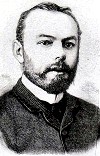SOUTH AFRICA
PRETORIA / JOHANNESBURG
THE DIAMOND MINES OF KIMBERLEY
PRETORIA / JOHANNESBURG
THE DIAMOND MINES OF KIMBERLEY
STAR OF AFRICA DIAMOND * EUREKA DIAMOND
>> << >> << >> << >> < <> > << >> << >> << >> <<
Article twenty-seven continues the recollections of the 1892-1895 world tour made by
Article twenty-seven continues the recollections of the 1892-1895 world tour made by
George Bullough, (later Sir George, Baronet, Kinloch Castle, Isle of Rum, Scotland)
and his travelling companion, Robert Mitchell, in a series of twenty-eight articles
by Mitchell published in the local Lancashire newspaper the Accrington Gazette in 1896.
Explanatory, numbered notes relating to the text, written from first-hand research by
George W. Randall, are to be found following the published article.
George W. Randall, are to be found following the published article.
> + <
INTRODUCTION TO AUTHOR:
Time of visit September / October 1893.
GOVERNMENT BUILDINGS - PRETORIA
Album X * Image 9 * Detail from full size 8 x 6 inches
The Raadsaal Building, Church Square, Pretoria, housed the parliament of the South African Republic from 1891 to 1902. RIGHT: A corner of the Dutch Reformed Church demolished 1905.
Pretoria was founded in 1855 on ground purchased by the Boer Government from Marthinus Wessel Pretorius, (1819-1901), first president of the South African Republic. Marthinus was born in Cape Colony son of Voortrekker leader, Andries Pretorius, (1798-1853), who was instrumental in the creation of the South African Republic.
<*> <*> <*><*> <*> <*> <*> <*> <*><*> <*> <*>
named after the adjacent Dutch Reformed Church,
part of which is visible right.
*<*> <*> <*>*<*> <*> <*> * <*> <*> <*>*<*> <*> <*>*
*<*> <*> <*>*<*> <*> <*> * <*> <*> <*>*<*> <*> <*>*
FRUE VANNERS ROBINSON GOLD MINING CO.
Album X * Image 7 * Size 11½ x 10 inches.
*<*> <*> <*>*<*> <*> <*> * <*> <*> <*>*<*> <*> <*>*
FRUE VANNERS ROBINSON GOLD MINING CO.
Album X * Image 6 * Size 11½ x 10 inches.
*<*> <*> <*>*<*> <*> <*> * <*> <*> <*>*<*> <*> <*>*
*<*> <*> <*>*<*> <*> <*> * <*> <*> <*>*<*> <*> <*>*
The Dutch
Reformed Church in Pretoria
was established in 1854, the first church being
built two years later, its location becoming the centre of the town. This first
building burnt down in 1882, the photograph depicts its replacement which was demolished in 1905.
This large open space around the church was used for out-spanning or resting animals, particularly the dozens of teams of oxen and mules used for hauling wagons every day prior to the railway connection.
Following the Anglo/Boer War, 1899-1902,the church, being deemed “unsafe”,
This large open space around the church was used for out-spanning or resting animals, particularly the dozens of teams of oxen and mules used for hauling wagons every day prior to the railway connection.
Following the Anglo/Boer War, 1899-1902,the church, being deemed “unsafe”,
was sold to the town authorities the proceeds
being utilised to build two new churches, it was demolished in 1905.
being utilised to build two new churches, it was demolished in 1905.
Encyclopædia
Britannica 11th Edition
>> << >> << >> << >> > << >> << >> << >> <<
ROODEPOORT CENTRAL GOLD MINING COMPANY
Album
X * One of six block-cuts on image 8 * Size 2 x 1½ inches
(Very much enlarged)
(Very much enlarged)
Roodepoort is north-west of central Johannesburg.
GOLD CRUSHING BATTERY – ROODEPOORT (GOLD MINE)
Album
X * One of six block-cuts on image 8 * Size of original 2 x 1½ inches
(Very much enlarged)
(Very much enlarged)
 |
| Roodepoort Gold - December 1890 crushing produced 1,215 ozs. gold |
*<*> <*> <*>*<*> <*> <*> * <*> <*> <*>*<*> <*> <*>*
FRUE VANNERS ROBINSON GOLD MINING CO.
Album X * Image 7 * Size 11½ x 10 inches.
*<*> <*> <*>*<*> <*> <*> * <*> <*> <*>*<*> <*> <*>*
FRUE VANNERS ROBINSON GOLD MINING CO.
Album X * Image 6 * Size 11½ x 10 inches.
 |
| From: Diamond
Mining in the Kimberley Field by Charles V. Allen 1903 |
*<*> <*> <*>*<*> <*> <*> * <*> <*> <*>*<*> <*> <*>*
MAIN REEF JOHANNESBURG - LINE OF REEF
Album X * Image 5 * Size 8 x 6 inches.
































































